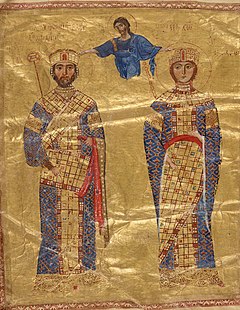
The loros (Greek: λῶρος, romanized: lôros) was a long, narrow and embroidered cloth, which was wrapped around the torso and dropped over the left hand. It was one of the most important and distinctive parts of the most formal and ceremonial type of imperial Byzantine costume, worn only by the Imperial family and a few of the most senior officials. It developed out of the trabea triumphalis of the Roman consuls. There were different male and female versions.[1] Byzantine sources speak of the "loros costume" as the loros dictated the rest of the imperial outfit. The slightly less formal, and more secular, imperial costume, which was also that normally worn by high officials on official occasions, was the chlamys costume.[2] Underneath either the loros or the chlamys were worn the divetesion (διβητήσιον), a long silk robe, and a tunic.[3]